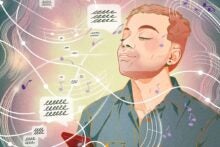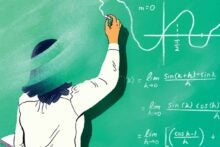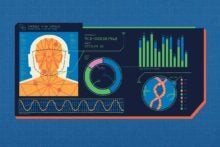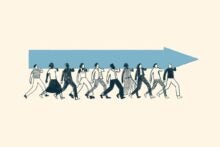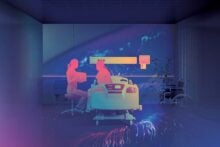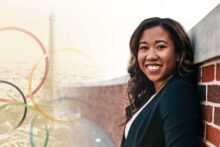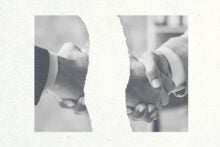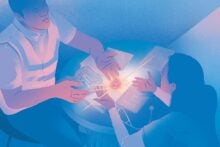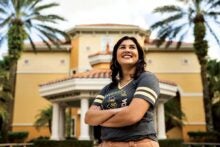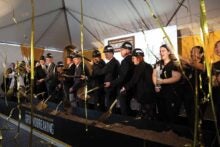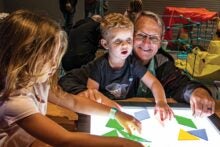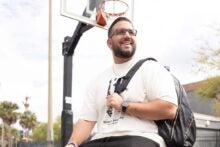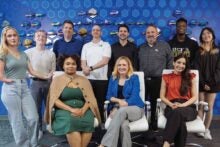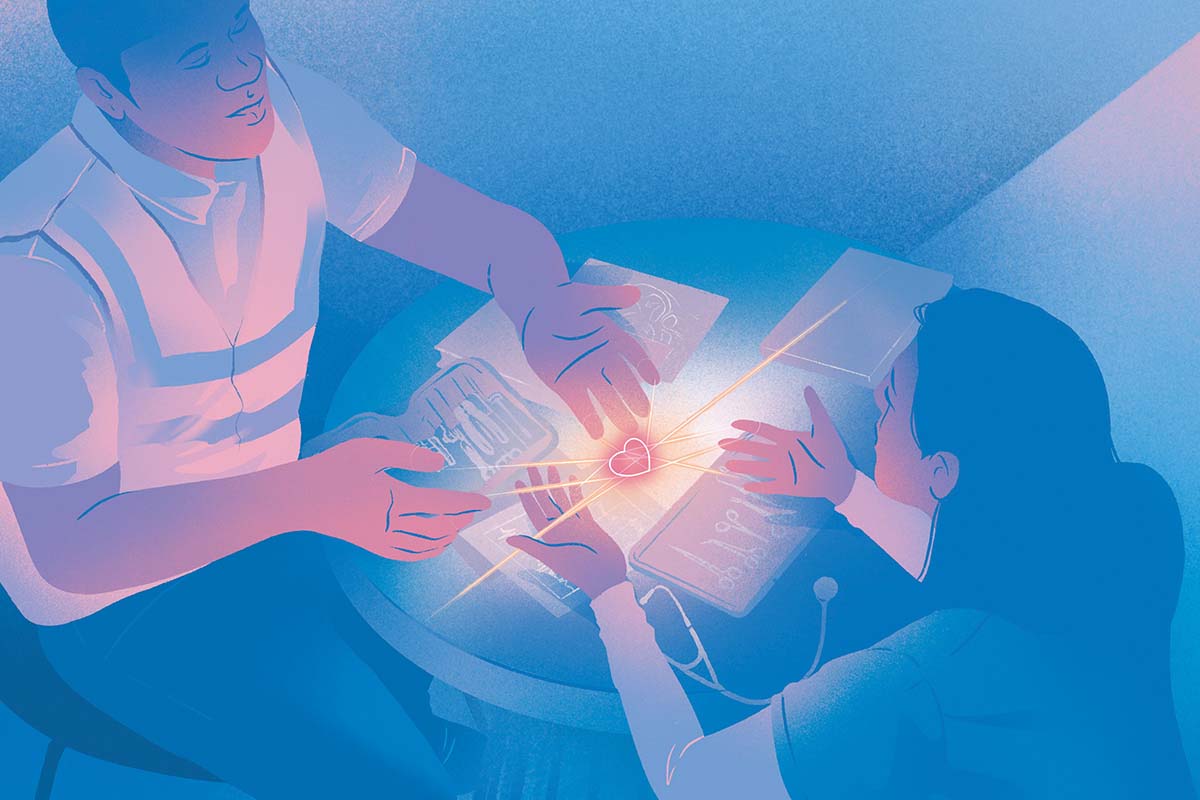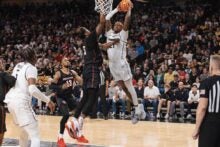
The heart was so tiny, no bigger than a plum. There in the operating room at Orlando Health Arnold Palmer Hospital for Children, UCF Pegasus Professor Alain Kassab watched in awe as a team of surgeons went to work, saving a life that had just begun. Kassab had collaborated for years on the research behind the procedure with William DeCampli, the hospital’s chief of pediatric cardiac surgery and professor of surgery at UCF. They’d explored drawings, analyzed the math and experimented with models in UCF labs.
“It’s one thing to collect data and use simulation,” Kassab says, “but to see it all come down to a little heart, with my own eyes, it’s hard to describe.”
On the surface, it might seem that Kassab and DeCampli come from different worlds. One is a pediatric heart surgeon. The other works in UCF’s Department of Mechanical and Aerospace Engineering. Separately, they’re highly respected in their spheres of influence. Together, they’re finding ways to keep hearts beating in the world we share.
“That’s why I’m here at UCF: for the collaboration and access to technology,” says DeCampli, who could literally be practicing anywhere. “To render the best care possible for children and adults with heart disease, one can no longer do this alone.”
The same can be said about a physics professor using a lunch break to visit an authority in virtual reality, or a philosopher talking with computer scientists about the ramifications of artificial intelligence. On a campus where fields of expertise are vast, the doors of progress are always wide open.
The Heart Surgeon and the Engineer
During video calls, DeCampli often sits at a desk where two words are visible on a wall above his head: Engineering Hope. He personifies cross-discipline proficiency in a white surgeon’s coat or, sometimes, in his MIT hoodie.
“We can turn concepts into big applications,” he says, “but first we have to take steps outside the box.”
Those steps come naturally for DeCampli. He earned a physics degree from MIT and a doctorate in astrophysics from Harvard University. He had a residency at Stanford University and a teaching position at the University of Pennsylvania, with clinical work at the Children’s Hospital of Philadelphia. Before working on little hearts, DeCampli was on track to work in space as an astronaut. He passed enough tests in the 1980s to make the list of semifinalists for NASA Astronaut Group 11, but then he took a sharp turn.
“I thought being a surgeon would provide a lifelong challenge and allow me to do more good for the world,” he says. “I believed this could be done with a combination of surgical expertise and multidisciplinary research.”
That’s why he rerouted his career to Orlando to lead pediatric heart surgery at Orlando Health Arnold Palmer Hospital for Children while UCF’s medical school was being built. He viewed UCF as a startup where he could collaborate on research with fewer limitations than at many other institutions.
The same kind of optimism drew Kassab to UCF, where he believed there might one day be a biomedical engineering program, a medical school and space to apply aeronautical technology. By the time UCF’s College of Medicine opened in 2009, physicians were already knocking on Kassab’s door. DeCampli was among the first.
“I’d just seen a poster in a colleague’s waiting room in New York,” DeCampli says. “The picture showed a heart with a ventricular assist device (VAD) implanted and it became my eureka moment.”
He noticed the angle of implantation of one of the cannulas, or tubes, on the VAD was likely to allow particles in the blood to move into the cerebral arteries where they could cause strokes. As soon as DeCampli returned to Orlando, he called Kassab. Together, they used math, sketches and laws of physics to develop a computer simulation and a “mock flow loop” — a benchtop simulation of the human circulatory system. With these experimental approaches, they were able to adjust angles and orientations of VADs and predict the probability of clots moving to the brain. DeCampli, Kassab and collaborator Eduardo Divo from Embry-Riddle Aeronautical University published their initial results nearly a decade ago. Their predictions were validated in September 2023 when researchers from a major heart center in Texas reported that the incidence of stroke was reduced from 50% overall to 10% in patients whose angle of implantation was optimized in the range predicted by the UCF team.
“This should be a wake-up call for surgeons around the world,” DeCampli says, “because there’s an opportunity to reduce stroke disability and possibly save lives.”
Earlier this year DeCampli was invited to lead a seminar at the Medical College of Wisconsin. The title of his presentation is a question that has driven his work with Kassab for the past 16 years: Can engineers cure congenital heart disease? Adventures in cross-disciplinary research.
“I’m no physician,” Kassab says, “but I know how to use computations from airplane designs to help us figure out the fluid dynamics of blood flow. I’d always wanted to be a part of medical research, and then [DeCampli] came along.”
They’ve used similar methods with the aim of improving the survival rate of children born with several congenital heart defects, including those with single-chambered hearts. With no intervention, the mortality rate of the latter defect is 80% to 100% within 12 months. To increase survival, these children need three operations. The first procedure, carried out in the first week after birth, is so remarkable that Kassab can only describe it as “replumbing the circulatory system.” The second and third operations are carried out around 6 months and 3 years of age, respectively. Even so, problems with circulation can develop later in life. Using a concept drawn from mechanical engineering and industrial applications, the UCF team designed a small implantable “injector jet” to assist circulation and potentially improve the longevity and quality of life of these children.
“It’s amazing to see everything come to that point, where he’s working on a little heart, doing good for humanity. That’s what this is all about.”
“It’s an idea born in aerospace,” Kassab says.
Each procedure follows the now familiar rhythm of their research: computer models go to the benchtop and the findings from the benchtop go to the surgeon’s hands — to the heart of their purpose.
“It’s amazing to see everything come to that point,” Kassab says, “where he’s working on a little heart, doing good for humanity. That’s what this is all about.”
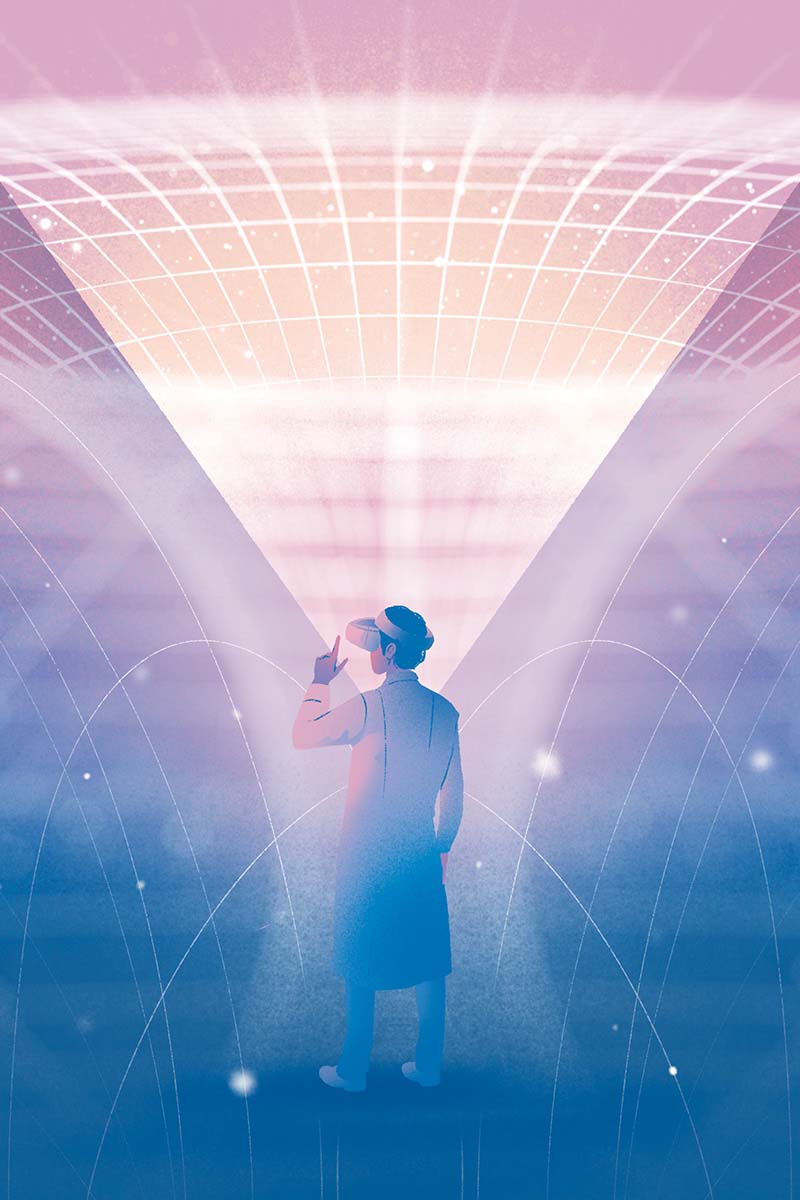
The Physicist and the Computer Scientist
At first, Eduardo Mucciolo had little interest in trying on the virtual reality (VR) headset. The idea that goggles could make quantum computing less complicated and more friendly sounded far-fetched. A student, however, urged him to try it.
“I thought it might be kind of silly,” Mucciolo says, “but when a student is excited about research, you listen. So I decided to go and see what she was talking about.”
Mucciolo did not have to make travel arrangements or navigate layers of approvals. He used a break in his day to walk from UCF’s Physical Sciences Building to the Barbara Ying Center. He sat down while the student, Pauline Johnson ’21 ’22MS, gave him a tutorial on how to use the VR goggles.
“Once I put them on, I couldn’t get enough,” Mucciolo says. “I stayed there for two hours.”
He lost himself in a 3D virtual world, where complex formulas and equations came to life as spheres and a movable vector. Prompts on the screen kept him from missing steps. The goggles themselves kept him engaged.
“If this technology can make a believer out of me,” Mucciolo thought, “imagine how it could excite more students about quantum computing.”
When he took off the goggles, he had one question for Johnson: “Who’s behind this?”
A few days later, Mucciolo the physics professor was sipping coffee with Ryan McMahan the computer science professor and lead researcher on the project.
“Eduardo was excited,” McMahan says. “We both know that quantum computing has unlimited potential and the U.S. National Science Foundation (NSF) believes it’s about to explode, but there will be a dearth of people who understand it. So, Eduardo and I talked about collecting more data, refining the application and eventually presenting VR goggles to his students as a testbed.”
Those students could then be among those to unlock the power of quantum computing to help with myriad needs, like expediting simulations for drug development, strengthening data security and advancing machine learning. The NSF recognizes the great potential of the research and supports it with a grant, ensuring the work continues.
But none of this would be happening if McMahan hadn’t been seated on an airplane next to another quantum physicist in 2019. The man emphasized the biggest factor preventing growth of quantum computing: intimidation. McMahan believed VR could change that. But at the time, he couldn’t do anything about it. As the only faculty member researching VR at the University of Texas at Dallas, his inbox was always flooded.
“It was overwhelming to be the only person answering questions about the technology,” he says.
A few months later, McMahan accepted a position at UCF to join a deep and growing roster of AR/VR researchers, where he would have the freedom to explore ideas with people across disciplines.
“He’s a computer scientist and I’m a physicist. But we both have an interest in education. That’s the motivation for us — easing more students into this new technology.”
“I consider it a blessing that Ryan and I met,” Mucciolo says. “He’s a computer scientist and I’m a physicist. But we both have an interest in education. That’s the motivation for us — easing more students into this new technology.”
Ironically, the software application that was intended to bring apprehensive students into quantum computing was originally designed by students in McMahan’s senior design class. And it was a student who convinced a reluctant Mucciolo to try them on before he became a collaborator.
“I had a good feeling about UCF when I came here 20 years ago,” Mucciolo says, “and this is an example of why.”

The Finance Specialists and the Computer Scientists
At a time when Venmo was only used between friends and crypto was still a fringe currency, Ajai Singh came to UCF to embark on a lofty goal: to build curiosity about finance among computer science students and build curiosity about computer science among finance students. The world would need fintech professionals, and UCF had an environment to create a learning program for them.
“There were universities with fintech courses, but no university had an entire curriculum for us to emulate,” says Singh, professor and chair of UCF’s Department of Finance. “So we became the template.”
It isn’t an easy template for other schools to follow.
“Fintech is one of those areas where UCF saw very early an opportunity to drive talent and research into a new tech industry,” says Rob Panepinto, senior strategic advisor and director of innovation districts strategy and partnerships in the UCF Business Incubation Program. “But it requires partnerships between business, computer science and engineering. Not many universities can do that.”
Singh had the liberty to form a world-class fintech team. Christo Pirinsky of the U.S. Securities and Exchange Commission (SEC) was among the first people he contacted.
“I liked my job with the SEC, and we’d been digging pretty deep into fintech, but I recognized an inflection point at UCF,” Pirinsky says. “It was growing not only in size but in quality, and I wanted to be a part of something that hadn’t been done.”
Pirinsky came as the co-director of UCF’s fintech initiative, a group that collaborates with professors in computer science and engineering. They are not separated by silos or legacies. In fact, UCF’s Department of Finance is the only one in the world that includes a tenured faculty member with a doctoral degree in computer science. All instructors share a common objective: to prepare elite professionals for the fintech industry.
“We’ve never had a school with an example to follow,” Singh says, “so we created our own path and continue to lead the way.”
Other prestigious universities quietly envy the rapid success of UCF’s fintech initiative. There were eight students in the first year of the undergraduate program. The number more than tripled a year later and it has grown exponentially ever since. In 2022, UCF launched the state’s first graduate program in fintech and one of the only such programs in the country.
“We’ve never had a school with an example to follow,” Singh says, “so we created our own path and continue to lead the way.”
Everyone and Artificial Intelligence
A voice rose above a recent onstage demonstration during UCF Celebrates the Arts. One of the university’s tech enthusiasts was showing the audience how artificial intelligence (AI) could analyze a picture he’d just taken of the room when someone called out, “But wait! Do you have permission from the people to use that?”
It’s one of a million looming questions about AI. Actor and hip-hop artist Common asked this big one at the end of a 2018 Microsoft commercial for AI: “You have more power at your fingertips than entire generations that came before you. So, here’s the question: What will you do with it?”
These questions have inspired as much collaboration as any ongoing research at UCF. The conversations bring together people in philosophy, writing and rhetoric, the arts, the sciences and engineering.
“This technology feels different,” says Jonathan Beever, who’s in the middle of many of the discussions. “There’s a combination of interest and concern.”
Who is Beever? He’s a philosopher, but not the solitary thinking kind. The NSF has awarded funding for his interdisciplinary research over the past four years. He’s tech-savvy enough to have developed an outdoor soundscape lab to analyze biodiversity in nature. He’s the founding director of the UCF Center for Ethics and helped launch Ethics and Digital Culture with Stephen Kuebler, a research professor of optics and photonics, and chemistry. Questions about AI have reached so many ears that, last year, UCF President Alexander N. Cartwright and Provost Michael D. Johnson expressed an immediate need to connect AI with humanities. Within eight months, Beever had developed a certificate program with Professor of Writing and Rhetoric Laurie Pinkert, drawing input from professors of every specialty in the College of Arts and Humanities.
“This is the topic being discussed around campus,” Beever says. “No matter what you’re studying, you want to understand how AI works, the potential benefits and risks, and how and if to use it. It’s related to everything we value as individuals and as a culture.”
To develop the program, Beever and Pinkert dove into both the micro practical questions around writing and creative arts, and the big-picture ethical questions for society.
“The questions are endless, so at the end of the day we want people to think about AI from every angle,” Beever says, putting the essence of all interdisciplinary research into a nutshell.
“Being at UCF allows me to explore beyond my own realm, and that’s how we all make progress.”
While spanning his own thoughts — curiosity, concern, excitement — Beever keeps going back to one: gratitude.
“I think about where I am and the importance placed on the work I’m doing,” he says, echoing the sentiment of every person in this story. “In a traditional position at a traditional university, I’d be told to focus on a narrow space. Being at UCF allows me to explore beyond my own realm, and that’s how we all make progress.”

